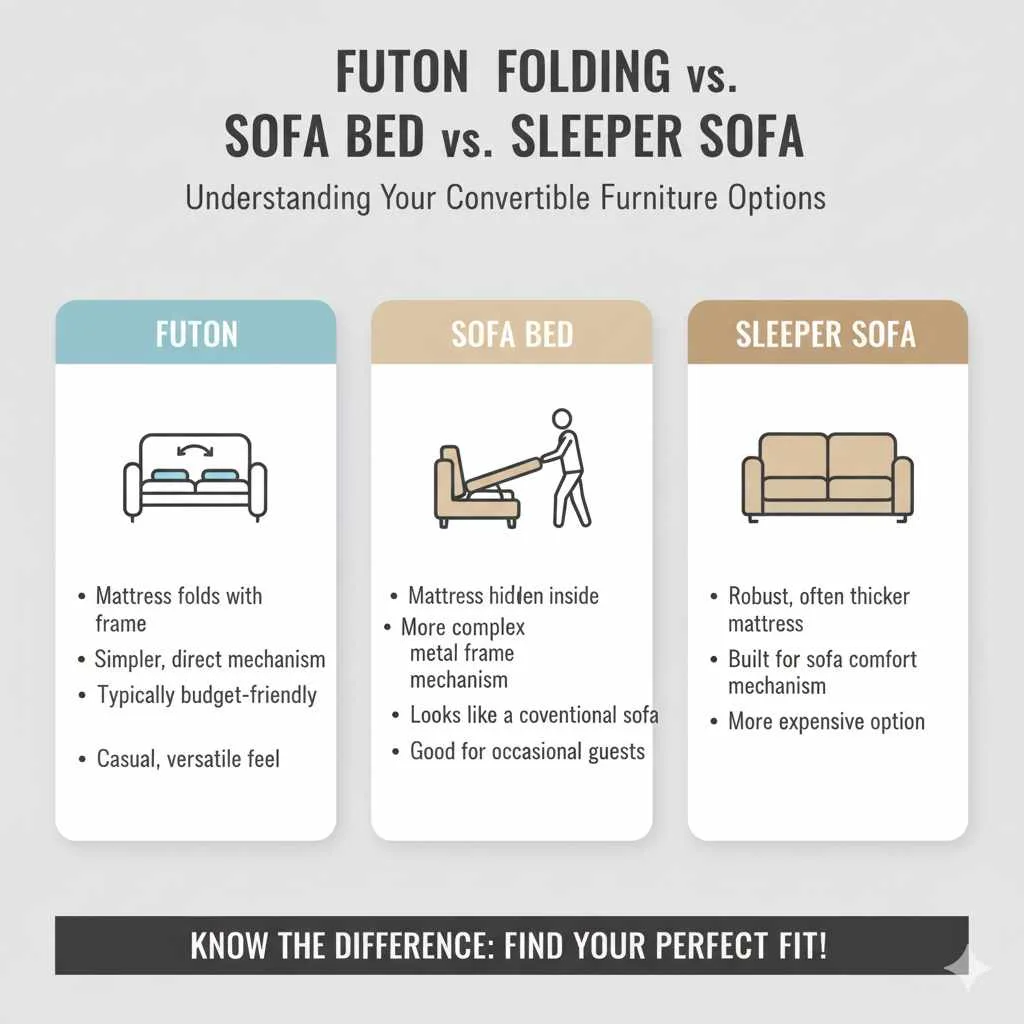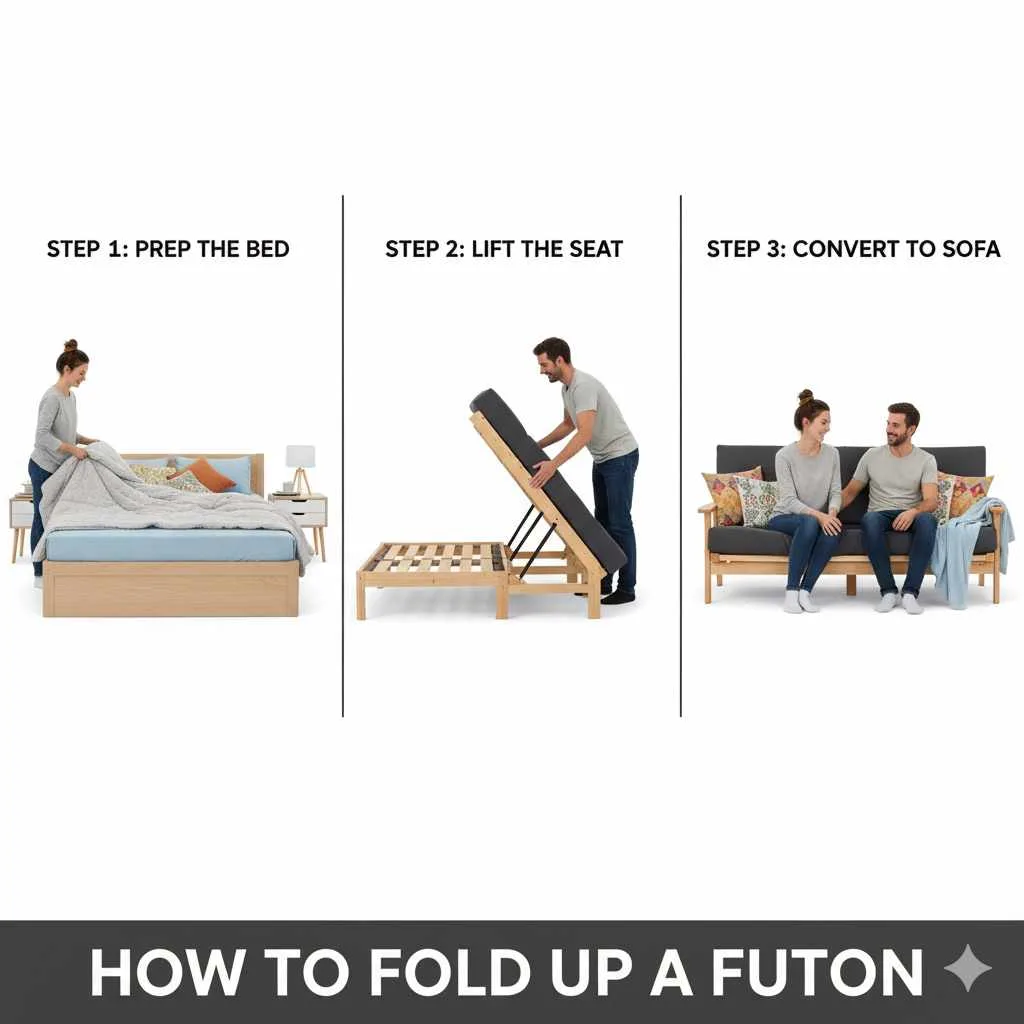Quick Summary: Folding up a futon is simple! Follow these easy steps to quickly convert your comfy sofa into a cozy bed, or vice versa, saving space and adding versatility to your room.
Welcome, fellow home enthusiasts! We’ve all been there: the need to transform a living space, a guest room, or a studio apartment. Futons are champions of versatility, serving as stylish sofas by day and welcoming beds by night. But sometimes, the prospect of folding one up can feel like a puzzle. Don’t worry! Today, we’re unlocking the secrets to effortless futon folding. You’ll discover how to neatly tuck it away or prepare it for a restful sleep with simple, step-by-step guidance. Get ready to maximize your space and enjoy the full potential of your futon!
Why Folding Up Your Futon is a Game-Changer
Futons are brilliant inventions that give you more bang for your buck when it comes to furniture. They’re perfect for smaller apartments, guest rooms, or even as a multifunctional piece in a living room. The ability to switch from a sofa to a bed and back again is their superpower! Knowing how to fold it up properly not only keeps your space looking tidy but also ensures the longevity of your futon. A well-folded futon looks neater, is easier to clean around, and is always ready for its next role.
It’s also about smart living. When you’re not using your futon as a bed, folding it back into a sofa instantly frees up floor space. This makes your room feel larger, more open, and much more functional. Imagine hosting friends with ample room to move, or simply enjoying a clutter-free zone after a guest departs. It’s all achievable with a little know-how.

Understanding Your Futon: The Anatomy of a Fold
Before we dive into the folding process, let’s quickly get acquainted with the parts of a typical futon frame. Most futon frames are designed to pivot, allowing the mattress to fold in half. You’ll usually find:
- The Seat Frame: This is the main support for the part you sit on.
- The Back Frame: This supports the backrest of the sofa.
- The Leg Mechanism: This allows the frame to fold and unfold smoothly.
- The Mattress: The essential comfort element that folds with the frame.
The magic happens when the seat and back frames work together, pivoting to bring the mattress into a folded position. Think of it like closing a book. The mattress is the pages, and the frame is the cover and spine.
Effortless Steps to Fold Up Your Futon (Sofa Mode)
This is the moment you’ve been waiting for! Folding your futon into its sofa form is usually a straightforward process. The goal is to get the mattress to fold neatly in half and the frame to rest in its upright, sofa configuration. Here’s how:
Step 1: Clear the Area and Prepare
First things first, ensure you have enough space to move around the futon. Clear any clutter from the floor and the futon itself. This makes the process safer and smoother. If you have decorative pillows or a throw blanket, set them aside for now.
Step 2: Identify the Folding Point
Look at your futon frame. You’ll notice it’s designed to bend in the middle, usually where the seat and back sections meet. This bend is the key to folding it. You should see a mechanism, often made of metal, that allows this movement.
Step 3: Gently Lift and Push
Now, the action! On one side of the futon (usually the seat portion), find a lever or simply apply gentle, even pressure. You might need to slightly lift the seat upwards and then push it towards the backrest. The frame is designed to pivot here. You’re essentially encouraging the front of the seat to rise and move backward.
Tip: Don’t force it! If it feels stiff, check for any obstructions or ensure the mechanism is free to move. Sometimes, a gentle jiggle or a push from both sides simultaneously can help.
Step 4: Guide the Mattress
As the frame pivots, the mattress will naturally follow. You might need to help coax the mattress to fold neatly in half. Imagine you’re folding a large blanket or a thick comforter. Guide the mattress so that one half folds over the other, creating a clean crease in the middle.
Step 5: Secure the Frame (If Applicable)
Many futon frames have a locking mechanism to keep them in the sofa position. This often involves a latch, a hook, or a resting post that prevents the frame from accidentally unfolding. Locate this mechanism and engage it. This is crucial for safety and stability.
You can usually find this on the sides of the frame, where the seat and back sections connect. It might be a simple metal tab that slides into place or a bar that rests in a groove.
Step 6: Adjust and Admire!
Once the frame is locked, take a step back and admire your work! Smooth out the mattress to ensure it sits as neatly as possible in its sofa form. The fold should be relatively even, and the frame should feel solid and stable. Now, you can return your decorative pillows and blankets, and enjoy your newly formed sofa!
Unfolding Your Futon to Bed Mode
Ready for guests to arrive or just craving a cozy movie night on the floor? Unfolding your futon into a bed is just as simple, and often even easier than folding it up. Here’s your guide:
Step 1: Disengage the Locking Mechanism
Head to the sides of your futon. Find the latch, hook, or bar that was securing the frame in its sofa position. You’ll need to disengage this. Usually, it’s a simple matter of lifting a lever or sliding a piece of metal out of the way. Be prepared for the frame to want to move.
Step 2: Gently Push Forward and Down
This is where gravity helps! Gently push the backrest of the futon forward. As you push, the frame will pivot, and the seat will extend outwards. Keep a steady, controlled motion. The backrest will move downwards and away from you, creating the bed base.
Important: Always ensure your hands and fingers are clear of the moving parts of the frame as it unfolds. Keep pets and small children away during this process.
Step 3: Guide the Mattress and Smooth
As the frame unfolds, the mattress will naturally follow. You’ll see the two halves of the mattress separate and lie flat. Your futon is now a bed! Once the frame is fully extended and resting flat on the floor, smooth out the mattress. You want to eliminate any significant creases and ensure it lies as flat and comfortable as possible for sleeping.
Step 4: Add Bedding
Now for the fun part! Add your fitted sheet, blankets, and pillows to make your futon bed cozy and inviting. Your instant guest bed is ready!
Troubleshooting Common Futon Folding Issues
Even with the simplest guides, sometimes things can be a little sticky. Here are a few common fumbles and how to fix them:
Futon Won’t Lock in Sofa Position
Cause: The locking mechanism might be misaligned, blocked by debris, or simply stiff from lack of use.
Solution: Visually inspect the locking points on both sides. Ensure no fabric or springs are caught. Gently try to jiggle the frame or push it slightly further into the sofa position to see if it clicks into place. If it’s very stiff, a little WD-40 sprayed sparingly on the mechanism might help (ensure it doesn’t stain your mattress!).
Mattress Doesn’t Fold Neatly
Cause: The mattress might be too thick, too firm, or the frame might not be fully aligned before folding.
Solution: Ensure the frame is perfectly aligned in its sofa position before you start folding. Sometimes, if the frame is slightly off, the mattress can bunch. Try to gently push and pull sections of the mattress to help it settle into a neat fold. For very thick mattresses, a perfect crease might be elusive, and that’s okay. The goal is functional folding.
The Frame Feels Wobbly in Sofa Mode
Cause: The locking mechanism might not be fully engaged, or a part of the frame might be loose.
Solution: Double-check that the lock is securely in place on both sides. If the wobble persists, examine the frame for any loose bolts or screws. You might need a wrench or screwdriver to tighten them. For major wobbles, consult your futon’s manual or manufacturer.
Choosing the Right Futon: Factors to Consider
While folding is the focus today, a quick note on choosing a futon can make the folding process even smoother in the long run. Not all futons are created equal!
Frame Material Matters
Futon frames come in various materials, each with pros and cons:
| Material | Pros | Cons | Best For |
|---|---|---|---|
| Wood | Aesthetically pleasing, natural look, can be sturdy. | Can be heavy, might scratch, quality varies greatly. | Living rooms, guest rooms where style is a priority. |
| Metal | Durable, strong, often more affordable, sleek look. | Can be cold to the touch, might require specific tools for assembly, can be noisy if not well-made. | Dorm rooms, apartments, high-traffic areas. |
| Composite/Engineered Wood | Lighter than solid wood, often designed for easy assembly, can mimic wood grains. | Less durable than solid wood or metal, may not hold up to frequent folding/unfolding. | Occasional use or budget-conscious buyers. |
Mattress Thickness and Material
The mattress is just as important as the frame. A mattress that’s too thick might resist folding cleanly. Memory foam or hybrid mattresses tend to fold better than very firm, dense-fill options. For more information on mattress types and how they might affect folding, resources like the National Sleep Foundation offer great insights into sleep surfaces.
Mechanism Type
Most futons use a simple pivot mechanism. However, some might have a more complex “click-clack” or ratcheting system. These can sometimes be a bit more fiddly to engage or disengage, but generally, they lock more securely. The basic principle of folding remains the same.
Maintaining Your Futon for Longevity
To ensure your futon continues to fold and unfold beautifully for years to come, a little regular care goes a long way. This helps prevent the stiffness and wear that can make folding a chore.
- Regular Vacuuming: Dust and debris can get into the folding mechanism. Vacuum your futon frame and mattress regularly, paying attention to the joints.
- Check for Loose Parts: Periodically, give the frame a once-over to ensure all bolts and screws are tight.
- Lubrication (Sparingly!): If you notice a squeaky or stiff mechanism on a metal frame, a tiny spray of a dry lubricant or WD-40 can help. Make sure to wipe off any excess to prevent staining the mattress or fabric. Check your futon’s manual for manufacturer recommendations.
- Avoid Excessive Force: Never yank or force the futon. If it’s difficult to fold, stop and reassess. Forcing it can damage the frame or mattress.
- Rotate the Mattress: If your futon mattress is reversible, flip and rotate it every few months. This ensures even wear and can help it maintain its shape, which aids in folding.
Futon Folding vs. Sofa Bed vs. Sleeper Sofa
It’s easy to get these terms mixed up! Understanding the difference can help you appreciate your futon’s unique advantages.
- Futon: Typically consists of a foldable frame and a mattress. It converts from sofa to bed by folding the mattress and frame. Simpler mechanism, often more budget-friendly.
- Sofa Bed: A traditional sofa with a mattress that folds out from underneath. Often has a hidden, more complex metal mattress support system. Can offer a more conventional sofa feel.
- Sleeper Sofa: Similar to a sofa bed, but the mattress system might be more robust, and the sofa itself is often designed more like a standard couch, with a focus on comfort as a sofa.
The key differentiator for futons is that the mattress is part of the sofa’s structure, folding with the frame. This makes the folding process quite direct. For more in-depth comparisons of different sleeping solutions, you might find guides from organizations like the Consumer Financial Protection Bureau helpful in understanding furniture purchasing decisions.

Frequently Asked Questions About Folding Futons
Q1: How often should I fold up my futon?
It’s best to fold your futon into its sofa position when it’s not being used as a bed. This keeps the mattress in better shape, prevents it from getting dusty, and makes your living space more functional by freeing up floor area.
Q2: Can I fold up my futon even if the mattress is thick?
Yes, most futons are designed to accommodate a range of mattress thicknesses. However, very thick or dense mattresses might fold less neatly. You might need to gently guide the mattress to fold evenly.
Q3: What if my futon frame is squeaking a lot?
Squeaking usually indicates friction between metal parts. Try to locate the source of the squeak and apply a small amount of lubricant, like WD-40, to the moving joints. Wipe away any excess afterwards to prevent staining.
Q4: Is it okay to leave my futon unfolded all the time?
While comfortable, leaving it unfolded long-term isn’t ideal. It takes up a lot of space, can make the mattress more prone to dust and wear, and might even cause the frame to sag over time if it’s not designed for constant bed-use support.
Q5: My futon seems heavier when folding. Is that normal?
Yes, the weight can vary depending on the frame material and mattress. It’s normal for it to require a steady push. If it feels unusually heavy or stuck, check for obstructions before applying more force.
Q6: How do I clean my futon mattress before folding it?
Spot clean any stains according to the mattress manufacturer’s instructions. For general cleaning, vacuum the mattress thoroughly on both sides before folding. Ensure any spot cleaning is completely dry before folding to prevent mildew.
Conclusion
And there you have it! Folding up your futon is not a daunting task but a simple, functional step to enhance your living space. By understanding the basic mechanics, following these clear steps, and occasionally performing a little maintenance, you can ensure your futon serves as both a comfortable sofa and a welcoming bed with ease for years to come. You’ve got this! Enjoy the flexibility and style your futon brings to your home.








Leave a Reply